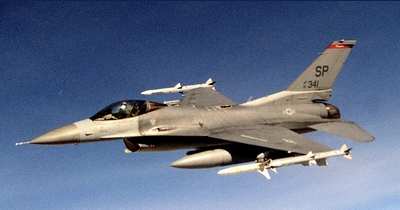Sun, Dec 05, 2010
Demonstration Flights For Raytheon System Flown By USAF,
Lockheed Martin
An Advanced Combat Radar, the latest Active Electronically
Scanned Array radar developed by Raytheon Company has successfully
completed a series of flight trials on a U.S. Air Force F-16 at
Edwards Air Force Base, CA. The radar demonstration flights were
conducted in partnership with the U.S. Air Force and Lockheed
Martin. The RACR team highlighted the multirole capabilities RACR
could bring to the F-16 Fighting Falcon, which included executing a
range of air-to-air and air-to-ground modes.

F-16 File Photo
RACR is the product of company-funded development, leveraging
Raytheon's proven capability in providing active electronically
scanned array radar technology for multiple platforms. The RACR
team completed development in a record 24 months. "AESA radar
technology has become a 'must have' for customers around the world
who need to keep their aircraft relevant in the swiftly evolving
battlespace," said Jim Hvizd, vice president, international
business development, Raytheon Space and Airborne Systems.
"Successfully flying RACR on an F-16 is another critical step in
demonstrating how we've optimized our AESA technology for F-16
customers, delivering the advanced radar capabilities they need to
maintain an operational edge.

"Raytheon's AESA technology also lowers operation and support
costs by an order of magnitude compared with those of mechanically
scanned radars, resulting in significant customer savings over the
life of a program," added Hvizd.
RACR is part of a family of Raytheon AESA radar systems designed
to equip multiple aircraft with a low-risk, high-performance,
affordable solution. The radar supports a rapid transition to
production, leveraging Raytheon's existing full-rate AESA
production lines, providing significant cost and schedule
advantages for customers.
"Raytheon's AESA technology brings unparalleled capability and
reliability to the F-16 at an acquisition cost comparable to the
old mechanically scanned radars," said Brian MacDonald, RACR
program manager, Raytheon's Tactical Airborne Systems. "RACR
is now available as an option for domestic and international
customers. We have designed, built and matured RACR from concept
through to F-16 flight demonstration to ensure we can support any
customer delivery time frames for new or retrofit aircraft
requirements."
More News
Its Offerings Are Lighter, Cleaner, and Now Pushing Past 1,000nm on SAF Jet Fuel DeltaHawk’s diesel-powered aircraft lineup has seen incredible upgrades over the last few yea>[...]
The Airplane Experienced A Total Loss Of Engine Power On December 3, 2025, about 1600 central standard time, a Mooney Aircraft Corp. M20K, N57229, was substantially damaged when it>[...]
Make Sure You NEVER Miss A New Story From Aero-News Network Do you ever feel like you never see posts from a certain person or page on Facebook or Instagram? Here’s how you c>[...]
Aero Linx: European Society of Aerospace Medicine (ESAM) As a pan-European, independent forum, it works to promote the safety and health of all persons involved in aviation and spa>[...]
“We are excited to see Wisk achieve this milestone, and I’m so proud of the team that made it possible. The team at Wisk has built advanced technologies across flight c>[...]
 Aero-TV: DeltaHawks Diesel Power Steps Into the Spotlight
Aero-TV: DeltaHawks Diesel Power Steps Into the Spotlight NTSB Prelim: Mooney Aircraft Corp. M20K
NTSB Prelim: Mooney Aircraft Corp. M20K ANN FAQ: Turn On Post Notifications
ANN FAQ: Turn On Post Notifications ANN's Daily Aero-Linx (12.20.25)
ANN's Daily Aero-Linx (12.20.25) Aero-News: Quote of the Day (12.20.25)
Aero-News: Quote of the Day (12.20.25)




